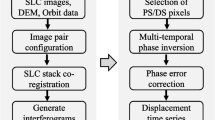Abstract
Knowledge about the state, spatial distribution and temporal evolution of the vegetation cover is of great scientific and economic value. Satellite platforms provide a most convenient tool to observe the biosphere globally and repetitively, but the quantitative interpretation of the observations may be difficult. Reflectance measurements in the visible and near-infrared regions have been analyzed with simple but powerful indices designed to enhance the contrast between the vegetation and other surface types, however, these indices are rather sensitive to atmospheric effects. The ‘correction’ of satellite data for atmospheric effects is possible but requires large data sets on the composition of the atmosphere. Instead, we propose a new vegetation index which has been designed specifically to reduce the relative effects of these undesirable atmospheric perturbations, while maintaining the information about the vegetation cover.
Similar content being viewed by others
References
Ajtay, G. L., Ketner, P., Duvigneaud, P. 1979. Terrestrial primary production and phytomass. In: The Global Carbon Cycle, SCOPE 13. Wiley and Sons, 129–171.
Asrar, G., Kanemasu, E. T., Jackson, R. D. & PinterJr., P. J. 1985. ‘Estimation of total above ground phytomass production using remotely sensed data’. Remote Sensing of Environment 17: 211–220.
Chedin, A., Scott, N. A., Husson, N., Flobert, J. F., Levy, C. & Moine, P. 1989. Satellite Meteorology and Atmospheric Spectroscopy. Recent Progress in Earth Remote Sensing from the Satellites of the TIROS-N Series. Journal of Quantitative Spectroscopy and Radiative Transfer 40: 257–273.
Gates, D. M. 1980. Biophysical Ecology. Springer Verlag, New York, 611 pp.
Goward, S. N., Tucker, C. J. & Dye, D. G. 1986. North American vegetation patterns observed with the NOAA-7 Advanced Very High Resolution Radiometer. Vegetatio 64: 3–14.
Holben, B. N. 1986. Characteristics of maximum-value composite images from temporal AVHRR data. International Journal of Remote Sensing 7: 1417–1434.
Holben, B. N. & Fraser, R. S. 1984. Red and near-infrared sensor response to off-nadir viewing. International Journal of Remote Sensing 5: 145–160.
Holben, B. N., Kimes, D. & Fraser, R. S. 1986. Directional reflectance response in AVHRR red and near-infrared bands for three cover types and varying atmospheric conditions. Remote Sensing of Environment 19: 213–236.
Koepke, P. 1989. Removal of atmospheric effects from AVHRR albedos. Journal of Applied Meteorology 28: 1341–1348.
Lee, T. Y. & Kaufman, Y. J. 1986. Non-lambertian effects on remote sensing of surface reflectance and vegetation index. IEEE Transactions on Geoscience and Remote Sensing GE-24, 699–707.
Malingreau, J. P., Stevens, G. & Fellows, C. 1985. 1982–83 forest fires of Kalimantan and North Borneo. Satellite observations for detection and monitoring. Ambio 14: 314–321.
Malingreau, J. P., Tucker, C. J. & Laporte, N. 1989. AVHRR for monitoring global tropical deforestation. International Journal of Remote Sensing 10: 855–867.
Sellers, P. J., 1985. Canopy reflectance, photosynthesis and transpiration. International Journal of Remote Sensing. 6: 1335–1372.
Sellers, P. J., 1987. Canopy reflectance, photosynthesis and transpiration: II. The role of biophysics in the linearity of their interdependence. Remote Sensing of Environment 21: 143–183.
Townshend, J. R. G. & Justice, C. O. 1986. Analysis of the dynamics of African vegetation using the normalized difference vegetation index. International Journal of Remote Sensing 7: 1435–1445.
Tucker, C. J., 1979. Red and photographic infrared linear combination for monitoring vegetation. Remote Sensing of Environment 8: 127–150.
Tucker, C. J., Holben, B. N., ElginJr., J. H. & McMurtreyIII, J. E. 1981. Remote-sensing of total dry-matter accumulation in winter wheat. Remote Sensing of Environment 11: 171–189.
Tucker, C. J., Vanpraet, C. L., Sharman, M. J. & Van, Ittersum, G., 1985. Satellite remote sensing of total herbaceous biomass production in the Senegalese Sahel: 1980–1984. Remote Sensing of Environment 17: 233–249.
Tucker, C. J., Fung, Y., Keeling, C. D. & Gammon, R. H. 1986. Relationship between atmospheric CO2 variations and a satellite-derived vegetation index. Nature 319: 195–199.
Verstraete, M. M. & Pinty, B., 1991. The potential contribution of satellite remote sensing to the understanding of arid lands processes. Vegetatio 91: 59–72.
Author information
Authors and Affiliations
Rights and permissions
About this article
Cite this article
Pinty, B., Verstraete, M.M. GEMI: a non-linear index to monitor global vegetation from satellites. Vegetatio 101, 15–20 (1992). https://doi.org/10.1007/BF00031911
Accepted:
Issue Date:
DOI: https://doi.org/10.1007/BF00031911




